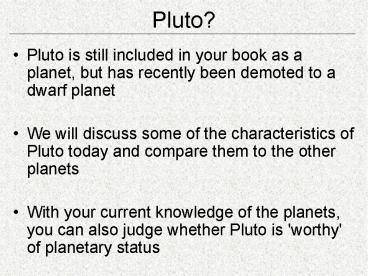Pluto? - PowerPoint PPT Presentation
Title:
Pluto?
Description:
Pluto? Pluto is still included in your book as a planet, but has recently been demoted to a dwarf planet We will discuss some of the characteristics of Pluto today ... – PowerPoint PPT presentation
Number of Views:181
Avg rating:3.0/5.0
Title: Pluto?
1
Pluto?
- Pluto is still included in your book as a planet,
but has recently been demoted to a dwarf planet - We will discuss some of the characteristics of
Pluto today and compare them to the other planets - With your current knowledge of the planets, you
can also judge whether Pluto is 'worthy' of
planetary status
2
Properties of Pluto
Semimajor Axis 39.5 A.U.
Orbital Eccentricity 0.249
Orbital Period 248 years
Rotational Period -6.4 days
Mass 1.27 x 1022 kg 0.0021 x Earth
Radius 1137 km 0.18 x Earth
Average Density 2.06 g/cm3 0.374 x Earth
Surface Gravity 0.66 m/s2 0.067 x Earth
Surface Temperature 40 - 60 K 300K for Earth
Atmosphere Methane?
3
Discovery of Pluto
- As was the case with Neptune, it was believed
that an unseen planet was still tugging on the
others - The lead searcher for this undiscovered planet
was Percival Lowell, who spent over a decade
looking - _
- Surprisingly, Pluto is too small to have any
gravitational effects on Uranus or Neptune, and
was found essentially by chance
4
Pluto's Orbit
- _
- At perihelion, Pluto is only 29.66 A.U. from the
Sun, while at aphelion, Pluto is 49.31 A.U. away - This orbit actually brings Pluto inside of
Neptune's orbit for a period of time - The two will never collide, however, because the
planets share a 32 resonance
Pluto orbits the Sun 3 times in the time it take
for 2 revolutions of Neptune
5
Observations of Pluto
Ground-based image
- Pluto's huge distance from the Sun and its very
small size make it hard to observe - _
- Ground-based measurements of the Pluto-Charon
system require the best telescopes on Earth - Hubble Space Telescope has provided the most
detailed images of Pluto and Charon to date
HST
6
Pluto and Charon
- Pluto and Charon are very similar in size
- Pluto diameter 2270 km
- Charon diameter 1300 km
- The two bodies are tidally locked, so that the
same side constantly faces the other body - _
- Recently, Pluto and Charon's orbit was aligned
with Earth so that many eclipses between the two
were visible
7
More Moons for Pluto
- In 2005, astronomers using the Hubble Space
Telescope discovered two more moons in orbit
around Pluto - The two small bodies are named Nix and Hydra
- _
- _
8
Pluto's Surface
- Direct measurements of Pluto's surface have not
been made, but it assumed to be an ice/rock
mixture - Spectroscopic studies have revealed the presence
of methane - _
- The 'image' at right is an HST model based on
multiple observations
9
Visiting Pluto
- The first probe to visit Pluto and Charon will be
the New Horizons spacecraft - New Horizons was launched in January of this year
- _
- This craft will provide the first real images of
Pluto and Charon's surface
10
What is Pluto?
- Pluto is far from the Sun, has a very odd orbit,
and exhibits characteristic more like a moon than
a planet - A combination of factors has led astronomers to
believe that Pluto may be a member of the Kuiper
belt - No matter what Pluto actually is, its title as a
planet has been stripped by the International
Astronomical Union
?
11
What Defines a Planet?
- _
- _
12
The Troublemakers
Note All images are artist conceptions
13
The IAU Definition
The definition of a planet as of August 2006 is
- _
- _
- _
A dwarf planet fulfills conditions 12. All
other objects are small Solar System bodies.

